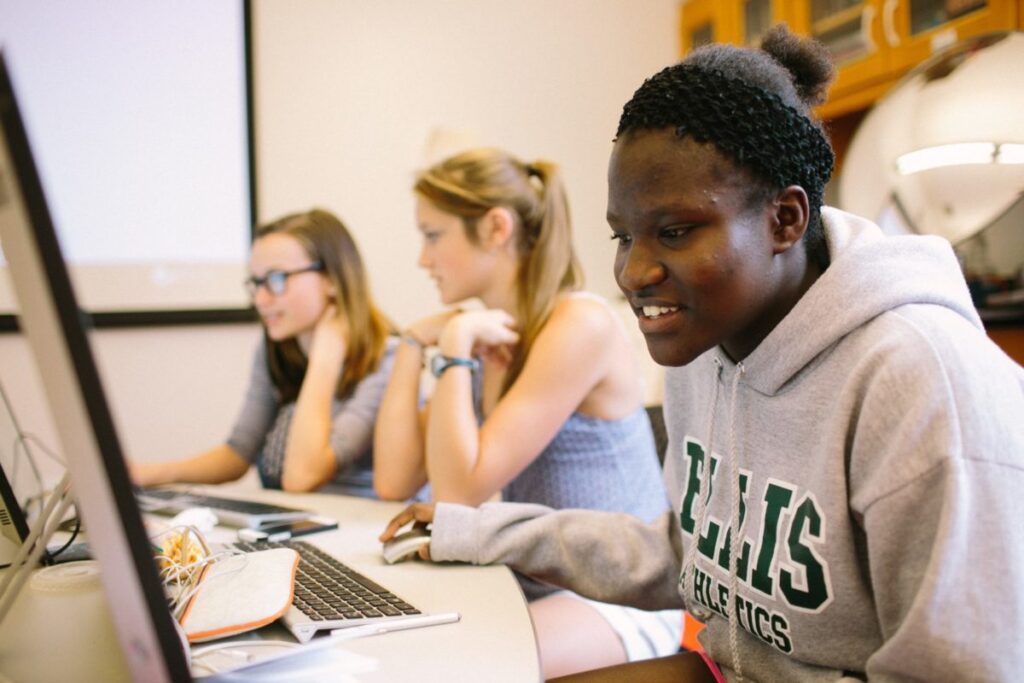Today’s learners will tackle the challenges and successes of tomorrow through complementary skills in science, technology, math, creative thinking, and artistic expression. But, not all learners have the same access to relevant, high-quality STEM and STEAM learning.
Research shows that more than a third of Black, Latino, and Native American students start college wanting a STEM-related degree—but less than half of them finish with one. (Source: National Center for Science and Engineering).
To help build the number of high-quality, diverse, and equitable STEAM learning opportunities in our region, Remake Learning’s Pittsburgh Regional STE(A)M Ecosystem has set four goals around STEAM program quality and evaluation for students of color. They want to learn more about STEAM programs currently serving black and brown students, develop (or adapt) an evaluation tool to address program quality, build evaluation capacity among STE(A)M Ecosystem stakeholders, and provide constructive program quality feedback to program directors and educators.
These goals evolved into what the Ecosystem today calls the STEAM Observation for Cultural Competency Community of Practice. Two Ecosystem members lead the Community of Practice: Dr. Gretchen Generett of Duquesne University, and Yael Silk of the Arts Ed Collaborative.
In late 2019, Gretchen and Yael visited four classrooms—all with a majority of students of color and led by educators of color—to observe culturally relevant STEAM teaching in action. This time provided an opportunity for in-person learning and direct feedback to educators. Their experiences will also inform a protocol of culturally-responsive competencies for STEAM education, to be developed by the Community of Practice.
We invited both Gretchen and Yael to share more about what they witnessed and what they took away from their experiences. Read on to hear from Yael, and click here to hear from Gretchen.
From Yael Silk:
Just the other day, I was sharing with the Arts Ed Collaborative team about how much it has meant to me to build a community of learners around cultural competency with the STE(A)M Ecosystem over the past number of years. I am simultaneously feeling the loss of pausing this effort due to school closures and grateful to know that the work will continue because it is now led by a growing group of curious and committed educators ready to engage critically and courageously. Now more than ever, I am thinking about what kind of learning opportunities our children deserve and how this historic period we are living through can be a defining turning point if we commit to making change together.
This work began in 2018 as an outgrowth of developing the Pittsburgh Regional STE(A)M Ecosystem’s theory of change. Inspired by the vision language that this ecosystem “will relentlessly cultivate diverse and equitable high-quality STEM learning opportunities, addressing real world challenges, for ALL students in our region with an eye toward building a scientifically-informed citizenry, and creative, prosperous, and resilient population,” I honed in on the notion that equity is a prerequisite to quality.
Together, LaTrenda and I talked about what teaching and learning must look like in order for racial, economic, and geographic identifiers to not be predictors of STEAM engagement. With input from the STE(A)M Ecosystem, we organized and defined three categories of quality indicators:
- General (e.g., high student engagement)
- STEAM-specific (e.g., focused on real world application)
- Cultural competency (e.g., educator embraces a facilitator/mentor stance)
Next, I adapted an observation protocol from Allegheny Intermediate Unit’s 2014 STEAM evaluation to explicitly incorporate evidence of culturally competent teaching practices. We also sought out a majority minority group of educators to conduct classroom observations. Each observation consisted of three components:
- Training on the observation protocol
- Observing teaching and learning
- Debriefing the observation
As an evaluator, I feel at ease in a classroom with a protocol in my hands. As a white educator committed to antiracist practices and celebrating Black educators and students, I was profoundly grateful to listen and learn. I saw and heard things that I would not have otherwise simply because they were not part of my lived experience.
The data we collected from the observation protocols highlighted meaningful information. Over 95% of teachers in Pennsylvania are white, so our observations were windows into a rare learning space. However, the real crux of this experience was always the debrief—each one was its own masterclass in unpacking culture, bias, pedagogy, and what it really means to care about young people.
Working alongside Dr. Gretchen Generett this past year raised the level of this work once more. She regularly made connections between what we saw in the observations to current teacher preparation practices. She was also consistently attuned to how perspectives change across generations and geographic regions. We revised the observation tool once again this year with input from Dr. Generett and the learning community participants.
Working on this project reinforced something that I know to be true given my arts education background: We CAN study issues that matter even when they are complicated and seemingly ephemeral. If we can describe it, we can measure it. It is possible. It takes time. And if we’re lucky, we can co-create meaning with a learning community.
